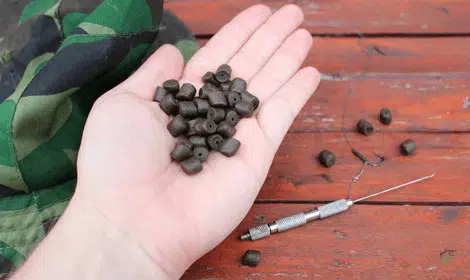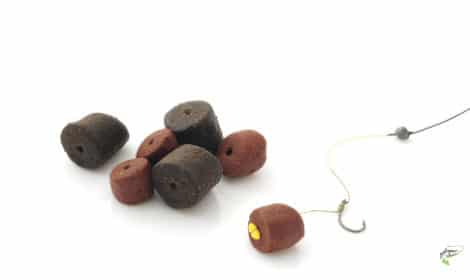
Pellets are extremely popular for catching commercial carp and other species of coarse fish swimming in the venues we all like to fish.
Pellets are a modern food created to feed fish, made up of (usually) a mixture of vegetable proteins, fats, carbohydrates, minerals, oils, and additives to create a bait that carp can’t resist.
Their high nutritional content is plenty to bring carp in from the area and get them feeding around your hook bait.
Commonly, micro pellets of around 2-4mm are used as a method feeder mixture, but many anglers still swear by using large as hook baits to try and get some carp in the net.
Just like boilies, there are many ways that pellets can be attached to a hook, and in this post, I am going to focus on how to put pellets on a hook so you can give it a go for yourself.
How to Put Pellets on a Hook? – The Easiest Way

Without a doubt, the easiest and most effective way to utilise pellets as hook baits is to hair rig them. Hair rigs are relatively new to the carp fishing world and were first invented and trialled in the 1980s.
Due to pellets being hard, they are nearly impossible to put directly onto the hook without breaking up. This is where hair rigs come in.
Hair rigs are methods of attaching bait to your rig without directly adding the bait to the hook. Carp are inquisitive and will investigate any food they deem may be edible.
They will sometimes suck the bait into their mouths to taste it and see if it reacts naturally in the water.
Hair rigs allow the hook to turn and move freely, and there is less chance the carp will eject the food as the bait should act more naturally in the water.
Hair rigs also allow you not to cover any of the hooks so your hook is far more likely to set properly if a hungry fish plucks your bait from the bottom.
But, enough of that,
Let’s examine how you can attach these pellets to your hair rig.
Commonly, pellets come in a pre-drilled form with a hole drilled through the centre of the bait, as shown in the picture above.
These holes allow you to pass the bait stop at the end of the hair rig through the pellet to lock it into place and stop it from sliding off the hair rig.
Unfortunately, I don’t have any pictures attaching a pellet to a hair rig, but I do have pictures of attaching sweetcorn, the process is almost identical, so I’ll use this for reference.
This method is extremely straightforward, but you will need a baiting needle for this.
1. Push the bait stop onto the end of the baiting needle.
2. Take your predrilled pellet and push the bait stop and the needle through the hole in the middle
3. Pull the bait stop off the end of the baiting needle and turn it horizontally and push the pellet against the bait stop.
4. Job done, it really is that simple.
Other Ways to Attach Pellets to Hooks
Although the hair-rigged method is the most common and usually the easiest, there are another few methods you can use if, for some reason, you want to mix it up and try something new.
Banded Pellet
Another common way to attach pellets to a hook is by using a pellet bander tool. You can buy pre-tied banded rigs, and by using a pellet bander tool, you can easily fix the pellet to the hook.
1. Push the band over the end of the pellet bander.
2. Push the button on the top to spread the band with the tool.
3. Put your pellet in the middle and let go of the button.
4 Pull the bander tool away from the pellet and pull the band down over the pellet.
Lasso Hair Rig

This method is slightly more advanced and involves tying a hair rig that allows you to tie a rig that the Lasso part will fix directly around the pellet without needing other tools.
The video above is great for showing you exactly how to do this.
That’s All
There is no doubt that pellets are some of the best baits for catching carp in commercial venues.
Some beginner anglers may be intimidated by how complicated hair-rigged pellet rigs can look. Still, there are extremely easy ways to attach pellets to a hook without the need for tying complicated rigs.
Pre-tied hair rigs are great for this; you will need to attach the pellet with one of the methods discussed above.
If you have any questions or anything you’d like to add, don’t hesitate to leave a comment below, and I’ll get back to you ASAP.


